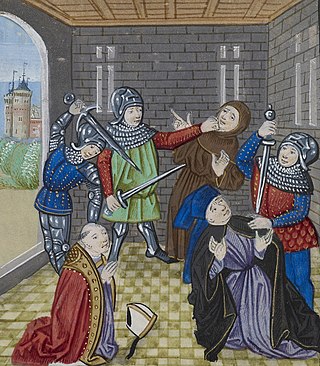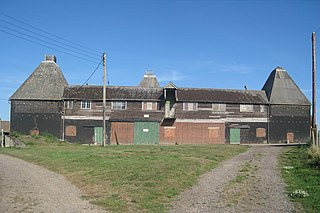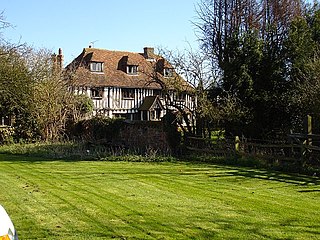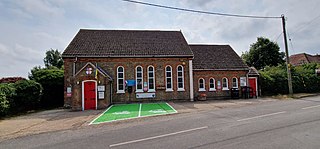
Faversham is a market town in Kent, England, 8 miles (13 km) from Sittingbourne, 48 miles (77 km) from London and 10 miles (16 km) from Canterbury, next to the Swale, a strip of sea separating mainland Kent from the Isle of Sheppey in the Thames Estuary. It is close to the A2, which follows an ancient British trackway which was used by the Romans and the Anglo-Saxons, and known as Watling Street. The name is of Old English origin, meaning "the metal-worker's village".

Stephen de Pencester was Warden of the Cinque Ports when the first authoritative list of Cinque Ports Confederation Members was produced in 1293.

Brogdale is a hamlet in Kent, England, immediately south of the M2 motorway, 2 miles (3.2 km) south of Faversham. It is one of several hamlets making up the civil parish of Ospringe and is in the Borough of Swale. Its western half is in the Kent Downs Area of Outstanding Natural Beauty.

Sir Robert Hales was Grand Prior of the Knights Hospitaller of England, Lord High Treasurer, and Admiral of the West. He was killed in the Peasants' Revolt.

Dunkirk is a village and civil parish between Faversham and Canterbury in southeast England. It lies on the Canterbury Road between Boughton under Blean and Harbledown. This was the main Roman road from the Kentish ports to London, also known as Watling Street.

Luddenham is a widespread hamlet or small village north-west of Faversham in Kent, England, with many long-distance views across the Swale and the Isle of Sheppey. It is on the edge of Luddenham Marshes and is also home of Luddenham School. Oare Gunpowder Works are on the edge of the village. It had, according to Edward Hasted in 1798, 396 acres of low flat arable land and 200 acres of meadow and pasture, although half of those are marsh. It is in the civil parish of Norton, Buckland and Stone.

Bobbing is a village and civil parish in the Swale district of Kent, England, about a mile north-west of Sittingbourne, and forming part of its urban area. The hamlet of Howt Green and village of Keycol are included within the parish. According to the 2011 census Bobbing parish had a population of 1,969.

Iwade is a village and civil parish 2 miles (3.2 km) north of the town of Sittingbourne in the English county of Kent.

Ospringe is a village and area of Faversham in the English county of Kent. It is also the name of a civil parish, which since 1935 has not included the village of Ospringe.

The Hospital of St Mary, Domus Dei, or Maison Dieu, is a medieval building in Dover, England which forms the oldest part of Dover Town Hall. The Town Hall and remains of mediaeval Maison Dieu were Grade I listed in 1973.

Oad Street is a small hamlet in the English county of Kent.
Goodnestone is a village and former civil parish, now in the parish of Graveney with Goodnestone, in the Swale district of Kent, England. The village is mainly on the road 'Head Hill Road' towards Graveney. In 1961 the parish had a population of 58.

Bredgar is a village and civil parish in the Borough of Swale, Kent, England.

Stalisfield is a village in the borough of Swale in Kent, England, located on a secondary road about 1½ miles (2.4 km) north of Charing and 5 miles south west of Faversham. The parish includes the hamlet of Stalisfield Green.

Oare is a village and civil parish north of Davington, Faversham in southeast England. It is separated from Faversham by the Oare Creek. To the north of the village are the Oare Marshes, and the Harty Ferry which once linked to Harty on the Isle of Sheppey. Kent Wildlife Trust manages a nature reserve that is an important stopping place for migratory birds.
Highsted is a village near Sittingbourne in Kent, England. It is in the civil parish of Rodmersham.

Painters Forstal is a village in the Swale district of the English county of Kent. It is 2 miles (3.2 km) south-west of the town of Faversham and is part of the civil parish of Ospringe. It lies just south of the M2 motorway, and has developed almost completely since the 1950s.
Gilbert Glanvill or Gilbert de Glanville was a medieval Bishop of Rochester.

Norton, Buckland and Stone is a small rural civil parish 1 mile (1.6 km) east of Teynham and 3 miles (4.8 km) west of the centre of Faversham in the borough of Swale, Kent, England. It is bypassed by the M2 to the south and traverses the historic A2, on the route of the Roman road of Watling Street.

Horne's Place Chapel, is a late mediaeval timber-framed house with private chapel in Appledore, Kent England.




















